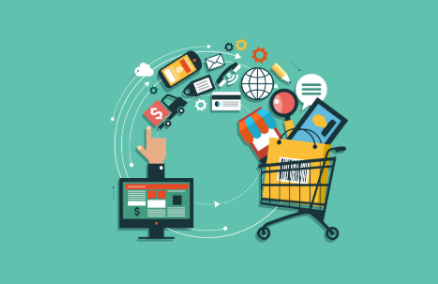The Struggles of Online Shopping

Image courtesy of Monster Insights.com
According to SleekNote, it was just over 27 years ago (1994) when the first documented online purchase was made. In modern times, the online share of total retail sales has steadily been on the rise—with e-commerce penetration hitting 16.0% in 2019, according to Digital Commerce. Especially since the COVID-19 pandemic caused lockdowns and quarantines, online shopping has increased in departments other than just clothing. It is now very common to order almost anything online like groceries, furniture, and order food delivery. U.S. e-commerce sales grew more than 30% between the first and second quarter of 2020, according to quarterly figures released by the U.S. Department of Commerce, illustrating that the pandemic has pushed more spending online. By 2023, Statista predicts that the e-commerce industry sales will surpass $6.5 trillion. Some huge online companies like Amazon are growing at astounding rates and Amazon is expected to account for 50% of all US e-commerce sales by the end of 2021 (Statista). Online shopping allows for a 24 hour, no checkout, delivery service that gives you access to thousands of products, but it also has no guarantee of quality, annoying backorders, and hidden charges. Is online shopping really worth it? And if so, what can you do to be safer and more satisfied with your online shopping experience?
Online shopping connects consumers with hundreds of thousands of sellers and stores and puts so many opportunities at their fingertips. For starters, online stores are open for purchases 24/7 making shopping easier in different time-zones or when you wake up in the middle of the night when you forgot to buy groceries. With a few clicks of a button, shoppers have access to a larger selection of products than would be found available in a store, and when they are done shopping, there is no annoying checkout line. Especially during the pandemic when people are trying to limit their outside contact, online shopping provides a contactless delivery of items crucial to living in quarantine. Online shopping also isn’t as much of a commitment as a real shopping experience; your cart can wait online for days until you have time to come back, add a few additional items, and check out. It is much less time consuming than driving to an actual store to pick up one item, just to be confronted with a very eager (and kind) salesperson that might make you feel a little pressured and uncomfortable. You can also read customer reviews to understand how the material is, the sizing matches up, and if they liked the product. And if they didn’t, there are so many similar items and brands that look almost identical for easy comparisons of price, sizes, and quality. Because of the competitive nature of online selling, prices tend to be lower for products than they would be in the store. Finally, the barrier and limitations of what you can fit into your car to get home are removed, as you are able to order beds, couches, and huge pieces of furniture online.
Though online shopping is able to help you find what you are looking for faster than in a real store, much of the reason that we shop is lost. Humans’ sense of touch is crucial to their enjoyment and connection to products, and without being able to feel the material of products, it is much harder to be sure of what you are buying. There is also a huge gap between what the product looks like online being worn by a skinny model then what the product looks like once it gets delivered. Shoppers are also unable to try on clothes that are being purchased online which often leads to getting the wrong size. And if you do get the wrong size, most companies have unclear and expensive return policies that are super frustrating. Though having so many different options is a great thing about online shopping, too many options that look the exact same, there is no guarantee of quality from smaller sellers, and it is hard to distinguish between quantity of items which can lead to a lifetime supply of cat food or bread crumbs when you only wanted a bit of each. Some companies use free shipping, which is great, but the others have huge shipping costs that can end up costing more than the item you wanted to buy. There is also a lack of security in your transactions because credit card information could be illegally intercepted by third parties if the checkout process isn’t set up perfectly. Even after shipping costs, it could take weeks or even months for some products to arrive, and sometimes the second after you checkout your item is backordered up to six months. The overlying issue with online shopping is that it is not most effectively designed for the consumer like a physical store would be. There is nobody to explain the added costs, sizing, or return policy, as well as no guarantee of fit, shipping, or delivery.
Whether online shopping is a world-wide success or failure, there are a few simple things that you can do to improve your online shopping experience and protect yourself from the bad parts of shopping online.
- According to the American Bar Association, it is best to use a credit card when paying online because federal law protects credit card uses from fraud and limits individual liability to $50. Using a credit card as opposed to other money transferring software is the safest way to protect yourself from any fraud that may be occurring during your transaction.
- Check the online checkout page’s web address. Online checkout pages should start with https instead of http. The extra ‘s’ shows that the website uses encrypted communications between sellers and consumers which protects you from third-party eavesdropping on your transactions
- Make sure to check return and privacy policies beforehand. This will make sure that you find a seller that will help you if your size is wrong or the product comes damaged.
- Make sure to double check your total matches the cost of the item plus taxes and shipping only. Online stores can hide charges in your final amount and most people forget to check
- Look out for coupon codes hidden on the website; many companies work them into the prices assuming that you will find them but many people forget to input the code
- Clear your cookies before shopping: according to Best Life, they will impact search results and even prices!
- Take time to look at other online stores before committing to one price, there are better ones out there
- Try curbside pickup to save on shipping
- Don’t always go straight to name brand products, they are usually more expensive

Campbell Portland is a freshman at Mendham High School. She enjoys playing soccer, basketball, as well as playing the Alto Saxophone and Bassoon in the...





